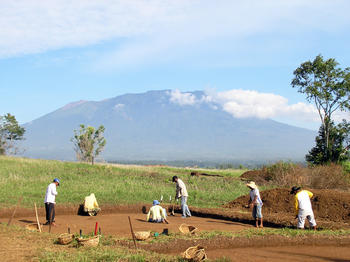Tanah Datar (Indonesia)
The team (external link)
The Project
The Tanah Datar project under the direction of Prof. Dr. Dominik Bonatz is a co-operation between the Freie Universität Berlin and the National Research and Development Centre Jakarta (Pusat Penelitian dan Pengembangan Arkeologi Nasional). The project involves researchers and students affiliated to the following institutions:
- Balai Pelestarian Peninggalan Purbakala Batusangkar
- Balai Arkeologi Medan
- École française d'Extrême-Orient, Jakarta
- National Museum of Ethnology, Leiden
- National Museum of Cambodia, Phnom Penh
- Universitas Indonesia, Jakarta
- University of Adelaide, Australia
- University of Boston, Boston
Early state formation in the context of lowland and highland exchanges on Sumatra
Sumatra has been renowned since the earliest times for its gold, camphor and precious forest products. The island has yet another asset: its strategic location, for Sumatra borders the Strait of Malacca, one of the world’s busiest maritime routes. For 2000 years trade linking China and India and points further west has passed its shores. Sumatra, and particularly its southeastern lowland and coastline, was thus a favourable place for early polities to develop. These coastal polities derived their wealth from controlling the Strait of Malacca and from trading highland products on the international market. By the late 7th century Srivijaya was the prominent trading power on Sumatra. Over time, highland regions and lowland polities developed complex interactions which we are only just beginning to understand.
Research was carried out in Tanah Datar, lit. “flat land”, a valley of the Minangkabau community, one of the most well-known highland communities on Sumatra. The Tanah Datar project aims to highlight the settlement history of this region. In the 14th century, Ādityavarman (1343-1375), a late ruler of Srivijaya-Malayu, moved the kingdom from the lowland region to the Minangkabau area. His reign, documented by various datable inscriptions, constitutes so far the only chronological anchor for the early history of the region.
The aims of this research project are as follows:
- to reconstruct settlement patterns before, during and after the interregnum of Ādityavarman,
- to document the material culture during the transition between pre- and early state formation in the highlands,
- to get a better insight of the relation between the highlands and lowlands and its effect on the socio-economic conditions of the highlands.
The archaeological project is connected to a philological research which aims to translate the whole corpus of the Ādityavarman inscriptions.
Campaign reports
from the 5th of March until the 17th of April 2011
